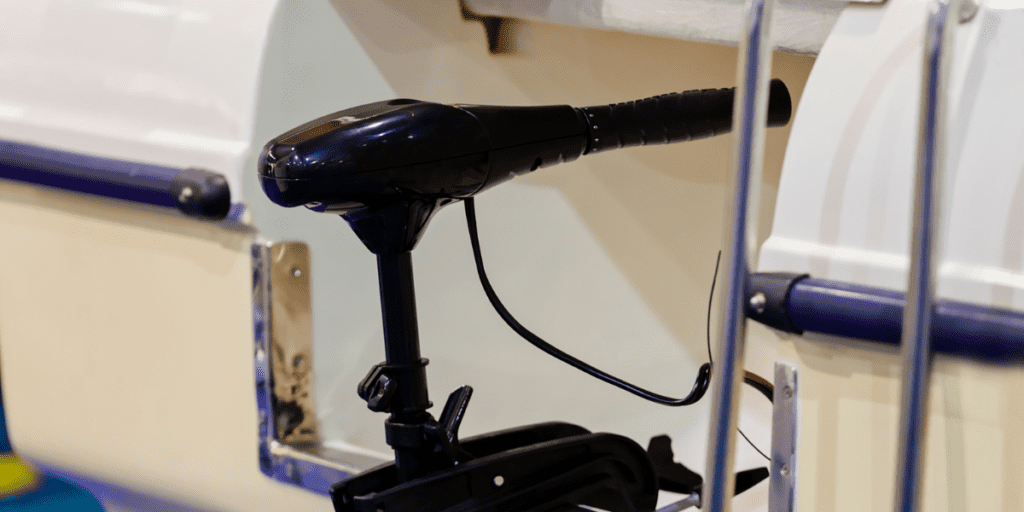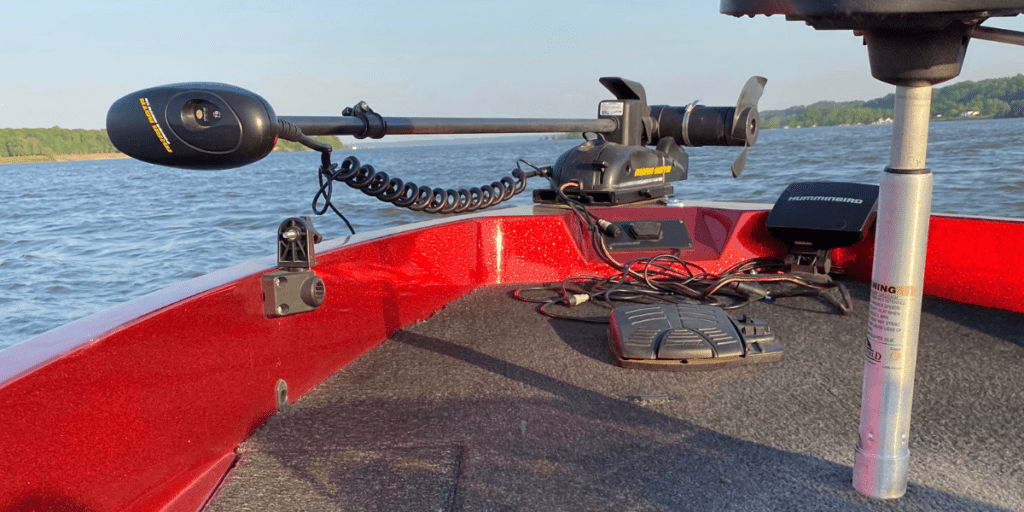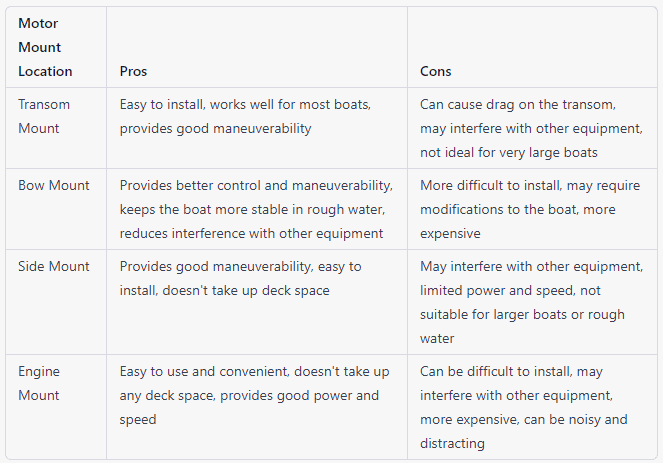Optimize Your Journey: Essential Trolling Motor Thrust Guide

Calling all adventure-seekers and fishing aficionados! Elevate your outdoor escapades with our all-encompassing trolling motor thrust guide. Delve into the nitty-gritty of shaft lengths, mounting options, and thrust power selection, tailored to equip you with the perfect companion for your aquatic pursuits.
Prepare to embark on an enticing journey as you uncover the intricacies of this indispensable gear, all in pursuit of that unparalleled fishing adventure.
Don’t wait any longer – immerse yourself now and explore the depths of trolling motor knowledge!
Table of Contents
What is a Trolling Motor?
A trolling motor is a type of electric outboard motor designed for use on small boats, kayaks, and canoes. It provides power to the boat without having to rely on an engine or oars.
It is attached to the vessel and has varying velocity settings, enabling one to voyage through water with various controlled velocities.
They are typically powered by either 12V or 24V batteries and feature adjustable speed settings allowing users to navigate their vessel with greater control than traditional rowing or paddling techniques.

Key Takeaway: Trolling motors provide an economical and efficient way to navigate small vessels, allowing anglers or outdoor enthusiasts to explore areas with greater precision than rowing or paddling. Electric propulsion systems, with their adjustable speeds, quiet performance, and reasonable cost of ownership in comparison to conventional outboard motors, make for a hassle-free boating experience.
Selecting the Right Trolling Motor
When selecting a trolling motor, consider factors such as size, power, speed settings, noise level, and additional features. Research different models to find the best fit for your needs, and consider warranties or service plans that could save money in the long run. Don’t solely focus on cost, as investing more in a quality motor may result in better performance and longevity.

Selecting a trolling motor for your boat or watercraft can be overwhelming, yet knowing the variables that enter into picking one and comparing various brands and models will assist you in making an educated choice. Now let’s explore what thrust is and why it is important when selecting a trolling motor.
Key Takeaway: When choosing a trolling motor, it is essential to think about the size and power of the engine as well as its sound level. For optimal value, consider researching models to determine which features suit your needs best.
What is Thrust?
Thrust is a measure of the power used to propel an object ahead. In relation to trolling motors, it is the power generated by the motor which pushes your boat or watercraft through the water.
The necessary trolling motor thrust for a boat depends on factors like size, weight, and desired speed. Knowing how much thrust you need can help you select the right trolling motor for your needs.
When choosing a trolling motor, one of the most important considerations is its maximum thrust output. This will determine how fast and far your boat can travel when using this type of propulsion system.
Generally speaking, larger boats require more thrust than smaller ones to achieve optimal performance levels. Additionally, if you plan on navigating challenging waters with heavy currents or strong winds then higher amounts of thrust may be necessary to maintain control over your vessel’s direction and speed.

Thrust is a critical element to take into account when selecting an outboard motor for your watercraft, as it can profoundly influence the functioning of your vessel. With that in mind, let’s take a look at shaft lengths and mounting options available for trolling motors.
Key Takeaway: To choose the right trolling motor for your needs, you must consider several factors such as boat size and weight, wind resistance coefficient (Cw), drag coefficient (CD), etc., to calculate the amount of thrust required. Research is key when selecting a model that will provide optimal performance levels; from lightweight options to high-powered torque beasts – there’s something out there for every fishing or boating enthusiast.
Shaft Lengths and Mounting Options for Trolling Motors

Shaft Length
Shaft length affects the overall performance and maneuverability of your boat or watercraft, so it’s essential to select the right size for your needs. There are several different types of shaft lengths available on the market, each with its pros and cons.
Short-shaft Motors
Short-shaft motors are typically used on smaller boats such as kayaks and canoes because they provide better control in shallow waters. These motors are more thrifty with energy, consuming less than their long-shaft alternatives.
Nevertheless, short-shaft motors may not be the ideal choice for bigger boats since they have limited power and reach.
Long-shaft Motors
Long-shaft trolling motors are ideal for larger boats that need extra thrust when navigating deeper waters or rough seas. They offer greater speed and range compared to short-shaft models but require more energy to operate due to their longer design.
Longer shafts also tend to be heavier than shorter ones which can make them difficult to mount on certain types of boats or watercraft without specialized mounting hardware or brackets.
Mounting Options
In addition to selecting the correct shaft length for your vessel, you must also consider how you will mount it onto your boat or watercraft before purchasing a trolling motor. Most common mounting options include transom mounted (for small outboard engines), bow mounted (for large outboards), and side mounted (for pontoon boats).

Realizing the multiple sizes of shafts and attachment means for trolling motors is essential to get the most out of your motor. With proper maintenance, it can be an investment that lasts many years. Next, we will explore some tips on how to keep your trolling motor in optimal condition over time.
Key Takeaway: Selecting the correct shaft length and mounting option for your trolling motor is essential to ensure maximum performance, maneuverability, and fuel efficiency. Transom mounts allow you to adjust the height while bow mounts keep it secure in all conditions; however, side-mounted units provide better visibility but are less stable at high speeds.
Maintenance Tips for Trolling Motors
Proper maintenance of your trolling motor is essential for ensuring its longevity and performance. The following tips will help you keep your trolling motor in good condition so it can serve you well for years to come.
Basic Care and Maintenance Guidelines
To ensure that your trolling motor lasts as long as possible, there are some basic care guidelines to follow.
First, make sure the propeller blades remain free from debris such as weeds or other plant matter. Also, be sure to clean off any salt deposits on the body of the motor with a mild detergent solution after each use in saltwater environments.
Additionally, lubricate all moving parts regularly using an appropriate lubricant such as WD-40 or 3-in-1 oil. Finally, check all wiring connections at least once a year and replace any frayed or damaged wires immediately.
Tips for Storing Trolling Motors
When not in use during off seasons, store your trolling motor indoors if possible; this will protect it from extreme temperatures which could damage components over time.
If storing outdoors is unavoidable, cover the entire unit with a waterproof tarpaulin to prevent moisture buildup inside the motor housing due to condensation when temperatures change rapidly between day and night cycles.
Be sure also to disconnect the battery before storage since leaving it connected can lead to corrosion over time due to chemical reactions within cells caused by temperature fluctuations while stored outdoors without protection against rain or snowfall accumulation on top of them
Key Takeaway: To ensure your trolling motor’s optimal performance and longevity, it is important to follow basic care guidelines such as keeping the propeller free of debris and cleaning off any salt deposits after use in saltwater. Additionally, make sure to store your motor indoors during off-seasons if possible, or cover it with a waterproof tarpaulin when storing outdoors; disconnecting the battery before storage will also help prevent corrosion.
Conclusion
In conclusion, it is important to understand the basics of trolling motor thrust before making a purchase. Thrust plays an essential role in selecting the right trolling motor for your needs and understanding shaft lengths and mounting options can help you make sure that your boat remains stable while using the trolling motor. Lastly, proper maintenance will ensure that your investment lasts longer so take care when using or storing your new trolling motor.
FAQs
How many pounds of thrust should trolling motors have?
The amount of thrust a trolling motor should have depends on the size and weight of your boat. It is important to note that if you plan on fishing in heavier currents or winds, it may be beneficial to invest in a trolling motor with higher levels of thrust.
How fast will a 100 lb thrust trolling motor go?
The speed of a 100 lb thrust trolling motor will depend on the type and size of the boat it is being used with. Generally, this type of motor can propel boats up to 6mph in calm water conditions. The speed of the boat may be reduced depending on its weight, resistance, and other external conditions such as wind or stream. In addition, higher speeds are possible when using multiple motors in tandem for larger vessels.
How many HP is 55 lbs of thrust?
The amount of horsepower (HP) generated by 55 lbs of thrust depends on the type and size of motor being used. Generally, a 55 lb thrust motor will produce between 2.5 and 3 HP depending on its size and efficiency rating. The larger the motor, the higher the HP output for a given amount of thrust.
How fast will a 40 lb thrust trolling motor go?
A 40 lb thrust trolling motor typically has a maximum speed of around 5 mph. The actual speed can be contingent on a number of things, such as the type and size of vessel, its load, and water circumstances. The actual speed achieved can also be affected by factors such as wind resistance or current direction. Generally speaking, however, most boats with a 40 lb thrust trolling motor should reach up to 5 mph when at full power in ideal conditions.
How to choose the correct battery – trolling motor thrust guide?
Choosing the correct battery to power your trolling motor is important for ensuring that you get the most out of your motor and its use. Generally speaking, the size and type of battery you choose should be contingent on the weight or thrust rating of your trolling motor.
